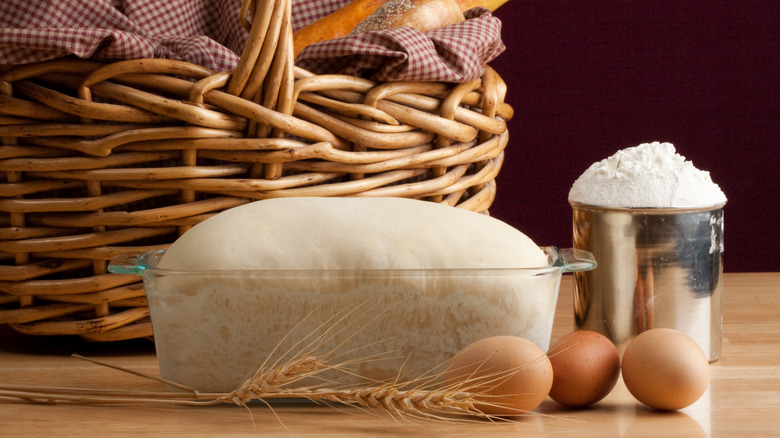Hot Water Might Just Be The Reason Your Homemade Bread Didn't Rise
It may seem surprising, but the truth is, thanks to the live yeast and other bacteria that call your dough home, bread from scratch is actually a living thing. Those organisms do the good work of creating the carbon dioxide necessary for bread to rise and develop all those delightful air bubbles and delicate crumb.
It is possible, however, to do some damage to their cozy ecosystem and ultimately destroy the environment that will allow your bread to become its best self. If you go through the steps of developing a dough and your bread doesn't rise, it might be because you've used extra hot water and killed off your once living yeast in the process.
Much like other living things, yeast thrives in certain conditions. When it comes to the temperature of the water you're planning to mix into your baking project, you want to be certain not to exceed 139 degrees Fahrenheit. Anything above this mark is much too hot for your yeast to survive.
If you don't have a thermometer on hand, simply play it safe by using the "wrist test." Water that feels warm, but not unpleasant to the touch, is the sweet spot, as anything over 120 degrees Fahrenheit will be painful. Yeast still likes to feel warm and is much less productive at cold temperatures, but it does its best work between 70 and 100 degrees Fahrenheit.
Other tips to keep your yeast happy
Yeast may be the hero of your bread recipe, but it is also picky about its environment. Making sure your yeast is comfortable and motivated is critical to getting an optimal bake. The following are a few more tips to ensuring happy, productive yeast.
Like temperature and moisture, sugar and salt both have an impact on your yeast's activity, so if you're choosing to manipulate a recipe, make sure to keep in mind that those ingredients have likely been calibrated for a reason. Freshness is also factor, and it's important to store your yeast properly until you plan to use it. Most vacuum-sealed packages are indefinitely shelf-stable, as long as they remain unopened. Once you crack into your stash though, transfer the contents of your bag to an airtight container or a zipper bag, and stick it in the freezer.
If you still have trouble on the rise, it might not be your fault. There's always the possibility that the store from which you purchased your yeast may not have stored it properly prior to sending it home with you. You can test your yeast's vitality by mixing a bit of sugar, yeast, and water together and checking for activity after about 10 minutes (bubbles mean you're good to go). But your best bet to getting off on the right foot is to buy your yeast from reputable, trusted sources whenever possible.
There are many uses for happy yeast
Once you know you have happy, vital yeast on hand and you're ready to bake your bread, you can choose so many different directions for carbohydrate satisfaction. A classic, sandwich-ready Pullman Bread recipe is a great place to start. Or try a dark loaf, like a Black Russian Rye Bread, and slather with butter and salt.
And though the list of breads are nearly limitless, loaves aren't the only creations that can employ your lively yeast, either. Snacks like a batch of sticky cinnamon buns, a malty twisted soft pretzel, chewy bagels, croissants, and their cousins, the Italian-style cornetti all call for yeast. For savory meals, Chinese steam bao buns, fluffy focaccia with herbs, and crusty pizza doughs all rely on strong rising power, too.
Sweeter fare like Mexican conchas, pull-apart Monkey bread, and classic doughnuts all call for yeast as well, as do breakfast staples like morning buns, waffles, pancakes, beignets, and babka. With a yeast you know you can count on, cared for at its favorite temperature, you can confidently explore so many well-risen possibilities.


